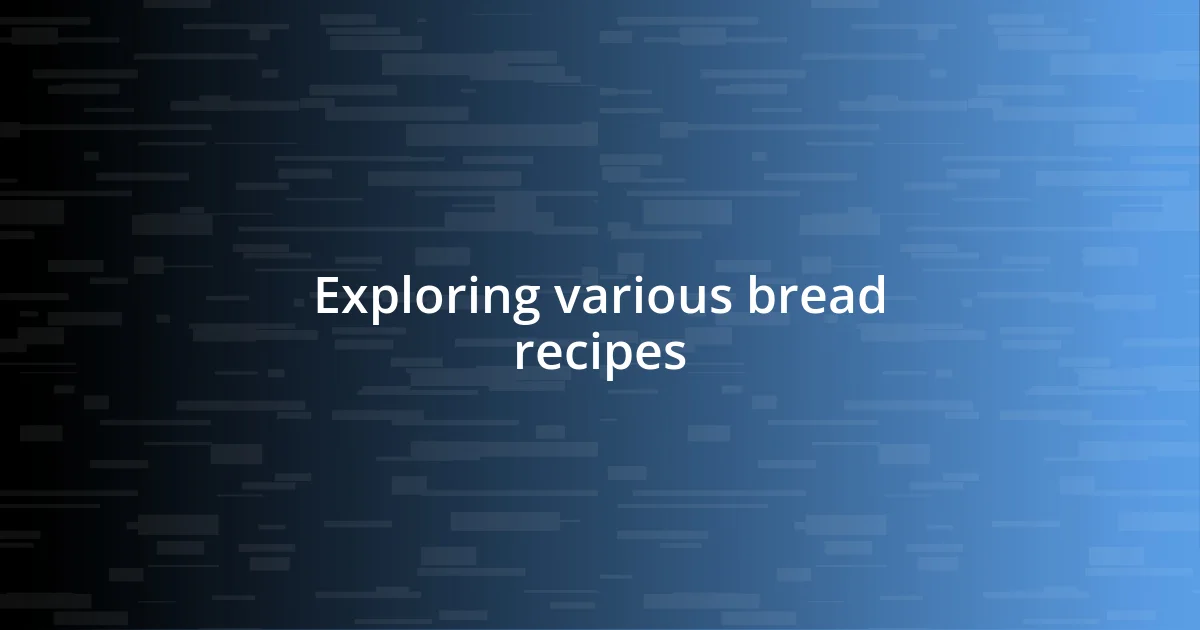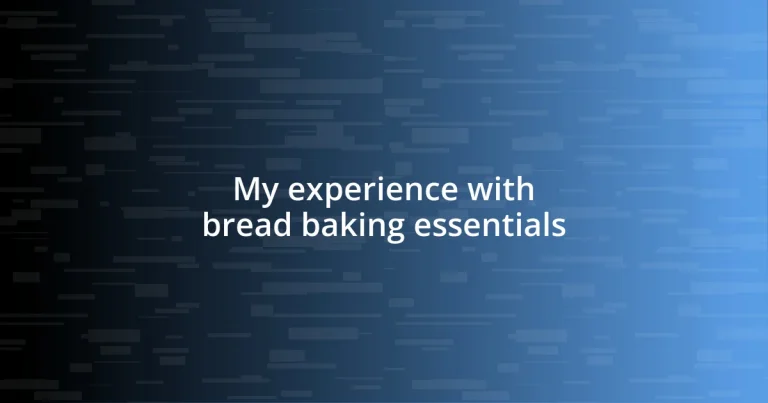Key takeaways:
- Understanding yeast’s role and accurately measuring ingredients, especially with a kitchen scale, are crucial for successful bread baking.
- Choosing high-quality ingredients, including flour and fresh yeast, significantly affects the texture and flavor of the bread.
- Mastering essential baking tools and proper dough consistency techniques enhances the overall baking experience and outcome.

Understanding bread baking essentials
When I started baking bread, I quickly learned that the essentials go beyond just flour and water. A key ingredient, yeast, is something I initially took for granted. Why does it matter? Well, think of yeast as the magician in your dough—it transforms simple ingredients into a fluffy loaf through fermentation. It was a revelation for me when I finally grasped its role in creating texture and flavor.
Measuring ingredients accurately changed my entire approach to baking. I remember the first time I added too much salt; it ruined the whole loaf! This taught me that precision is vital. Do you ever wonder why some recipes call for weight measurements instead of cups? It’s because weight offers consistency, leading to reliable results. Trust me, investing in a kitchen scale has made my bread baking more reliable and enjoyable.
Another essential I cherish is my oven. It took time to discover its quirks; my first few loaves were either burnt or undercooked. I realized that every oven is unique—some may have hot spots, while others may not circulate heat evenly. Have you ever considered how your oven can impact your baking? Understanding its idiosyncrasies has helped me create the perfectly golden crust I crave.

Choosing the right ingredients
Choosing the right ingredients can truly be the difference between a loaf that impresses and one that disappoints. I once experimented with different types of flour, realizing that using bread flour instead of all-purpose flour can elevate texture and structure. The extra protein in bread flour adds that wonderful chewiness, which is something I never thought about before!
One of my lightbulb moments happened when I discovered the importance of water quality. Initially, I used tap water without thinking much of it. But after switching to filtered water, I noticed a significant improvement in the dough’s rise and flavor. It’s incredible how something as simple as water can have such an impact on your baking success.
While you cannot overlook yeast, I have also found that using fresh ingredients is paramount. Older, inactive yeast can lead to dense bread with little rise. I learned this the hard way after a baking session where my dough barely inflated, and I was left with a sad, flat loaf. I now make it a point to check the freshness of my ingredients before starting any baking project.
| Ingredient | Impact |
|---|---|
| Flour Type | Affects texture, structure and chewiness |
| Water Quality | Influences dough rise and flavor |
| Yeast Freshness | Determines fermentation effectiveness |

Mastering essential baking tools
Mastering the essential tools of bread baking has been one of the most rewarding parts of my journey. I remember the first time I purchased a good quality bread knife; it felt like I had leveled up my baking game. This simple tool made it so much easier to slice through crusty loaves without squishing the soft interior. I truly believe that having the right tools not only enhances the baking experience but also elevates the final product.
Here are some of the must-have tools that have made a significant impact on my baking:
- Digital Kitchen Scale: Precision in measuring ingredients consistently ensures the best results.
- Bench Scraper: This versatile tool is perfect for cutting dough and scraping surfaces clean, which I found incredibly helpful after a messy bake.
- Bread Pan: A sturdy pan is crucial for shaping and baking, as I learned when my first loaf collapsed in a flimsy pan!
- Thermometer: Knowing the internal temperature of the bread helps in achieving that perfect doneness; my loaf was once undercooked because I skipped this step.
- Proofing Basket: I’ve enjoyed using these as they help shape the dough and create beautiful patterns on the crust.
Diving deeper into these tools has both simplified and enriched my baking practice. For instance, I underestimated the power of a good rolling pin until one day my dough seemed impossible to flatten. That’s when I realized the right rolling pin—not too heavy or light—allowed me to exert just the right amount of pressure, making the task effortless and even enjoyable. Having high-quality tools transforms not just the process, but it also brings joy in moments where I once found frustration.

Getting the perfect dough consistency
Getting the dough consistency just right can be quite a game changer in bread baking. I vividly remember my first attempt at a sourdough, where I ended up with a dough that was either too sticky or too dry. It was a frustrating, hands-in-the-flour moment that taught me the importance of the “windowpane test.” This technique involves stretching a small piece of dough until it forms a translucent membrane, indicating that gluten has developed properly. Have you ever faced the sticky situation where dough clings to everything? That’s a clear sign to assess your hydration levels and flour type.
As I delved deeper into the intricacies of dough consistency, I realized that temperature plays a huge role, too. My kitchen tends to heat up when I’m baking, and I’ve learned that warmer dough ferments faster. I’ve occasionally neglected this detail, resulting in overly bubbly dough that didn’t shape well. Monitoring the dough’s temperature has become a key part of my process. It’s amazing how something as simple as a thermometer can take your loaf from mediocre to magnificent, don’t you think?
Lastly, I’ve found that practice truly makes a difference. At first, I struggled with the concept of kneading, unsure of how much was “enough.” There were times when my dough seemed uncooperative, resisting my eager hands. But after multiple tries, I started recognizing that magical moment when the dough went from shaggy to smooth and elastic. It’s even better than any workout I’ve done! Embracing these little victories has transformed my confidence in the kitchen. With each batch, I’ve learned, adapted, and honed my skills—making the pursuit of perfect dough consistency a thrilling adventure!

Exploring various bread recipes
Exploring various bread recipes has been an exciting adventure for me. I remember the joy I felt when I first tackled a classic French baguette. The combination of kneading, waiting for the dough to rise, and then the blissful aroma that filled my kitchen was unforgettable. There’s something magical about shaping that dough into long, slender loaves, watching them transform in the oven. When they emerge with that perfect golden-brown crust, I can’t help but smile—a true testament to the technique and patience I’ve developed over time.
As I experimented with recipes, I discovered how different types of flour dramatically affect the texture and flavor of the bread. My first attempt at a whole wheat loaf was a humbling experience; I ended up with a denser bread than I anticipated! It made me appreciate the subtle nuances of each recipe, like how vital it is to adjust hydration levels when using whole grain flours. Isn’t it fascinating how a mere tweak in ingredients can lead to vastly different outcomes? This revelation propelled me to dive deeper into the world of sourdough, focaccia, and even sweet brioche, each offering unique lessons along the way.
One recipe that stands out is my first attempt at a no-knead bread. Initially skeptical about skipping the kneading process, I was blown away by how easy and forgiving it is. Mixing together a handful of ingredients, letting it rest overnight, and then baking created a delightful crust with a soft, airy center. The simplicity of it struck a chord with me; sometimes, less truly is more. Have you ever had a baking experience that felt too easy to be true? This journey reminds me that the beauty of bread baking lies in both its simplicity and its complexity—there’s always something new to learn, and every recipe tells its own story.

Troubleshooting common baking issues
When it comes to troubleshooting common baking issues, I’ve often found myself scratching my head, especially with rising dough. I remember once making a classic white bread that didn’t rise as expected. The culprit? Old yeast! It dawned on me that not all yeast has the same lifespan, and checking the expiration date is crucial. Have you ever pulled out a packet and wondered if it’s still good? Trust me, fresh ingredients make all the difference in achieving that fluffy, airy bread we all crave.
Another common problem I faced was baking bread that turned out too dense. After some experience, I realized an overlooked factor was my shaping technique. During one of my earlier attempts with challah, I didn’t shape the braids tightly enough, which led to a disappointing loaf. Now, I know to pay close attention to how I form and place my loaf in the pan. Properly shaping not only affects appearance but also contributes significantly to the bread’s internal structure. Isn’t it fascinating how the smallest details can impact the whole process?
Lastly, let’s talk about crusts—sometimes they’re too hard, other times, they lack that desirable crunch. I recall a time when my artisan bread emerged from the oven looking perfect, but the crust was so tough it felt like I needed a chainsaw! After researching, I discovered that steam is key in creating that crispy outer layer. Now, I always place a pan of water in the oven or use a spray bottle to mist the dough just before baking. It’s amazing how a little steam can completely change your bread experience, don’t you think?

Tips for successful bread storage
When it comes to bread storage, I’ve learned that the right environment can significantly prolong freshness. After a delightful baking day, my first instinct was to wrap my bread in plastic wrap. However, I quickly discovered that it traps moisture, leading to soggy crusts. Instead, I now opt for a bread box or a paper bag, which allows for optimal airflow while keeping the bread from drying out too quickly. Have you ever bitten into bread that just didn’t have that crispy bite? The storage method can really make a difference!
One memorable experience I had involved storing my beloved sourdough. I was so thrilled with the crust that I decided to use a cloth bag for a couple of days. To my dismay, it dried out faster than I anticipated! Learning from that, I now wrap my sourdough in a clean kitchen towel, and then place it inside a plastic bag, combining the benefits of breathability with moisture retention. It was a small revelation that made my next baking success even sweeter, and I can’t stress enough how crucial it is to find a balance in your storage techniques.
Something else I’ve discovered is the importance of slicing only what you need. Early in my bread baking journey, I would slice the entire loaf to savor it. This indulgence sometimes led to bread going stale faster. Now, I slice pieces as needed, keeping the rest intact— this not only preserves freshness but also gives me that moment of anticipation each time I reach for a slice. It’s amazing how these little habits can transform the way we enjoy our homemade loaves, don’t you think?














